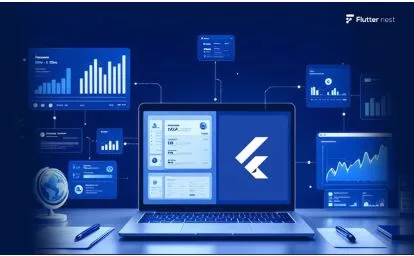Why Flutter is the Future of Web App Development?
Introduction
Flutter started out as a mobile development framework — and quickly became a favorite for building high-performance apps with beautiful UIs. But over the past few years, it has expanded well beyond smartphones. Today, Flutter isn’t just for mobile — it’s also a powerful tool for building web applications.
Whether you’re launching a new product, developing an internal tool, or scaling an MVP to more platforms, using Flutter for web app development lets you unify your codebase, streamline design, and speed up delivery — all without compromising on user experience.
But like any platform, building for the web with Flutter comes with its own set of considerations — from performance and routing to layout and deployment.
In this blog, we’ll walk you through the complete journey: from planning and setup to final deployment. Whether you’re exploring Flutter for web development for the first time or transitioning from a mobile app, this guide will give you a clear roadmap to get it done right.
Explore The Flutter Web App Development Roadmap
Flutter has emerged as a powerful framework for building cross-platform applications, including web apps, with a single codebase. Its hot reload feature, expressive UI components, and high performance make it an excellent choice for web development. Whether you’re a beginner or an experienced developer, Flutter simplifies creating responsive and visually appealing web applications. This roadmap will guide you through the essential steps—from setup to deployment—to help you build a seamless Flutter web app. Let’s explore why Flutter is a great fit for the web and how to get started.
- Why Choose Flutter for Web App Development
If you’re wondering whether Flutter is just for mobile apps, think again. Flutter has evolved into a robust, multi-platform framework — and it’s becoming a serious contender in the web space too.
Why are more startups and product teams adopting Flutter for web app development? With its fast development cycle, cross-platform flexibility, and cost-efficiency, Flutter is becoming a top choice for startups looking to scale quickly.
Learn why Flutter for startups is a game-changer in our detailed guide. From MVP development to full-scale applications, Flutter empowers teams to build high-performance apps with a single codebase.
Unified Codebase
With Flutter, you can build for Android, iOS, and the web — all from a single codebase. That means faster development, fewer bugs, and less time spent maintaining separate platforms.
UI Consistency Across Devices
One of Flutter’s biggest strengths is its pixel-perfect rendering. Whether it’s a desktop browser or a mobile screen, your app will look and behave exactly the way you intend. This is especially valuable for brands aiming for consistency across platforms.
Ideal for Internal Tools, MVPs, and Dashboards
If you’re building admin panels, business dashboards, or early-stage MVPs, Flutter’s rapid development cycle can help you ship faster — without worrying about juggling multiple front-end frameworks.
Developer Experience
Flutter’s widget-based approach makes UI development intuitive and modular. Plus, with hot reload, real-time debugging, and a growing package ecosystem, the developer experience is smooth and efficient.
How it Compares to Traditional Web Frameworks
Unlike traditional web stacks like React + HTML + CSS, Flutter uses its own rendering engine. That can mean slightly larger bundle sizes — but in return, you get complete control over design and interaction, without worrying about browser inconsistencies or CSS quirks.
- Planning Your Flutter Web App
Before you jump into coding, it’s essential to map out exactly what you’re building and why. Thoughtful planning is what separates a quick prototype from a scalable, production-ready web app.
Here’s how to approach planning when using Flutter for web app development:
Define Your Scope
Start by asking: Is this an MVP or a long-term product? MVPs should focus on core features that solve a specific problem. Larger builds may need more architectural planning, scalability considerations, and long-term maintainability.
Choose the Right Layout Structure
Flutter supports both single-page applications (SPA) and multi-page routing. SPAs are ideal for lightweight dashboards or tools, while multi-page apps suit more complex workflows like CRMs or marketplaces.
Map Out Features and User Flows
Create a clear list of must-have features, nice-to-haves, and post-launch priorities. Think in terms of user actions — not just screens. For example: “upload files,” “view real-time data,” “edit profile,” etc.
Consider Platform-Specific Requirements
Some web apps may require:
- Integration with third-party API
- Admin authenticatio
- Desktop-first layout design
- Offline access or PWA capabilitie
Outlining these early helps avoid rewrites later.
Component-Based UI Planning
Flutter’s strength lies in reusable widgets. Plan your UI around reusable components (like cards, buttons, forms, and tables), which not only makes your app scalable but also easier to maintain.
When done right, this planning stage lays a solid foundation — saving you time, cost, and complexity as development progresses.
- Setting Up Your Flutter Web Development Environment
Getting started with Flutter for web development is straightforward if you’ve worked with Flutter before. Here’s a quick setup checklist:
- Install Flutter with Web Support
Use the latest Flutter SDK. Run flutter doctor to confirm web support (you should see Chrome or Web Server listed)
- Use a Supported IDE
VS Code and Android Studio both work well. Just ensure Flutter and Dart plugins are installed
- Run Your App in the Browser
Use flutter run -d chrome to launch the app directly in your browser with hot reload
- Preview Responsiveness
Use tools like the device_preview package to test across screen sizes without leaving your browser
- Structure Your Project
Organize code with folders for widgets, models, services, and views. Use SVGs or compressed assets optimized for web
With the setup complete, you’re ready to design and build your Flutter web app — directly in the browser.
- Designing the UI for Web in Flutter
Designing for the web brings a few extra considerations compared to mobile — but Flutter makes it easy to build responsive, polished interfaces across screen sizes.
Here’s how to approach UI design when using Flutter for web apps:
Build Responsive Layouts
Use tools like LayoutBuilder, MediaQuery, and Flexible/Expanded to adapt layouts across devices. Web users expect resizable windows and multi-column layouts, so think beyond mobile constraints.
Handle Web-Specific Behaviors
Add interactivity where it matters — like hover effects, cursor changes, or keyboard navigation. Flutter supports these natively through gesture detectors and mouse regions.
Reuse Components
If you’re building for both mobile and web, design with reusability in mind. Keep core widgets consistent and break layouts into smaller, modular components.
Design Systems Help
Consider creating your own design system or using existing component libraries tailored for Flutter. This ensures visual consistency and speeds up development.
Good UI on the web isn’t just about looking nice — it’s about adapting well, behaving predictably, and feeling natural in a browser environment.
- State Management and Routing for Web Apps
State management and navigation are critical in any app — but on the web, things like URL behavior and deep linking add extra layers to consider.
Here’s how to approach it with Flutter for web app development:
Routing That Works Like the Web
Use go_router or Navigator 2.0 for web-friendly navigation. These handle URL synchronization, browser history, and deep linking — so users can refresh or share pages without breaking the experience.
Manage State Clearly
Choose a state management solution that matches your app’s complexity:
- Provider for simple app
- Riverpod or BLoC for apps with more business logic or shared stat
- Keep state decoupled from UI to maintain modularity and testabilit
Handle Page Refreshes
Unlike mobile, web users hit refresh often. Make sure your app preserves state or fetches it gracefully after reloads. This might involve local storage or state hydration logic.
In web apps, how your app feels when navigating or reloading matters just as much as what it shows. Smooth routing and smart state handling are key to making it feel native to the browser.
- Backend Integration and APIs
Any serious web app needs to talk to a backend — whether it’s for authentication, fetching data, or syncing user activity. Flutter handles this well with the right setup.
Here’s how to approach backend integration when using Flutter for web app development:
REST or GraphQL — Both Work
Flutter supports both out of the box. Use packages like http, dio, or graphql_flutter depending on your preference and project scale.
Authentication for Web
For web apps, use solutions like Firebase Auth, OAuth 2.0, or custom JWT flows. Just make sure tokens are stored securely — ideally in memory or short-lived local/session storage, not persistent storage.
Persistent Data
For local storage, shared_preferences works, but for web-specific needs, consider hive or direct window.localStorage wrappers. Be cautious about storing sensitive data.
Graceful Error Handling
Always account for network delays, failed requests, and timeouts. Use retry logic and loading indicators to maintain a smooth UX.
Flutter makes integration seamless — just make sure your API layer is modular, testable, and decoupled from your UI for long-term scalability.
- Testing Your Flutter Web App
A great-looking app isn’t enough — it needs to work reliably across browsers, screen sizes, and edge cases. Testing is critical in Flutter for web app development, especially when you plan to ship to a wider audience.
Here’s what to focus on:
Automated Testing
Use Flutter’s built-in support for:
- Unit tests (business logic
- Widget tests (UI behavior
- Integration tests (full user flows
You can run these with flutter test or integrate them into CI pipelines.
Cross-Browser Manual Testing
Your app should behave consistently across Chrome, Safari, Edge, and Firefox. Test navigation, responsiveness, input handling, and any third-party plugins in each.
Use Performance and Accessibility Tools
Tools like Lighthouse help test performance, SEO, and accessibility directly in Chrome. They’re especially useful before launch.
CI/CD for the Web
Automate your web builds and test runs using GitHub Actions, GitLab CI, or Bitrise. It ensures your app stays stable after every commit.
A strong testing strategy gives you confidence that your web app won’t just run — it’ll run well for everyone.
- Performance Optimization for Flutter Web
Flutter web apps can look and feel great — but if they load slowly or lag on interaction, users won’t stick around. Optimizing performance is key to delivering a smooth, production-ready experience.
Here’s where to focus:
Keep Bundle Size in Check
Use Flutter’s tree shaking and deferred loading features to strip unused code and reduce initial load times. Also, keep third-party packages to a minimum.
Optimize Assets
Compress images and use web-friendly formats (like SVGs or WebP). Remove unused fonts and avoid large asset files unless lazy-loaded.
Lazy Loading & Code Splitting
For larger apps, load only what’s needed when it’s needed. Split your app into modules and defer heavy screens or logic.
Use DevTools to Monitor
Flutter DevTools helps inspect rendering, memory use, and rebuild frequency. Run audits regularly — especially during UI-heavy updates.
Well-optimized Flutter web apps feel just as snappy as their native counterparts — and users notice the difference.
- Deploying Your Flutter Web App
Once your Flutter web app is built and tested, it’s time to get it live. Fortunately, deploying a Flutter web app is straightforward — and there are several reliable hosting options.
Build for Web
Run:
flutter build web
This generates a build/web folder with static files (HTML, JS, CSS, assets) ready to host anywhere.
Choose Your Hosting Platform
Popular options include:
- Firebase Hosting – Simple CLI deployment, SSL, and CDN include
- Netlify or Vercel – Ideal for fast, developer-friendly static site hostin
- GitHub Pages – Free for open-source or small project
Set Up Domain and SSL
Most platforms offer easy domain mapping and HTTPS out of the box. Custom domains can be added via your DNS provider.
Plan for Updates
Since Flutter builds are static, you’ll need to re-deploy after every update. Automate this with CI/CD tools like GitHub Actions for seamless delivery.
Deployment is where your app meets the real world — make sure it’s smooth, fast, and production-ready from day one.
Final Thoughts
Flutter has grown far beyond its mobile roots — and it’s now a serious option for modern web development. Whether you’re building an internal dashboard, a public-facing product, or an MVP to test an idea, using Flutter for web app development offers speed, consistency, and a unified development experience.
What makes Flutter especially appealing is its ability to let teams build once and deploy everywhere. For companies looking to streamline engineering while still delivering polished, performant web apps, it’s a strong choice.
That said, success with Flutter on the web depends on more than just choosing the framework. Planning carefully, structuring your app properly, and optimizing for web-specific behavior are what make the difference between a basic port and a great product.
If you’ve already worked with Flutter on mobile, the transition to web will feel natural. And if you’re starting from scratch, Flutter still offers a powerful, future-ready foundation for building responsive and elegant web experiences.





